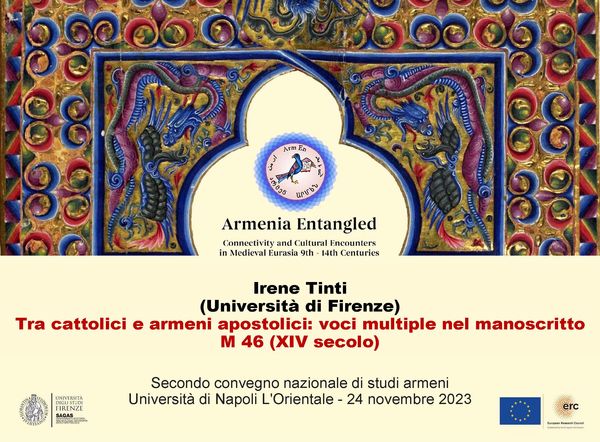ArmEn and HAI Mobility Team Members at the Secondo convegno nazionale di studi armeni (2 nd National Conference in Armenian Studies), Naples
On 23 and 24 November 2023 ArmEn team member Irene Tinti and HAI Mobility team member Sara Scarpellini took part in the Secondo convegno nazionale di studi armeni (2nd National Conference in Armenian Studies), organised by Giancarlo Schirru, Manuel Castelluccia, Andrea Di Manno, and Lorenzo Pubblici at the University of Naples ‒ L’Orientale. The theme of the conference was Unità e molteplicità nella storia armena (Unity and Multiplicity in Armenian History).

Tinti presented a paper titled “Tra cattolici e armeni apostolici: voci multiple nel manoscritto M 46 (XIV secolo) [ricerca condotta nell’ambito del progetto ERC ArmEn]” (“Between Catholics and Apostolic Armenians: Multiple Voices in Manuscript M 46 from the 14 th Century [Research Results of the ERC project ArmEn]”. She discussed a concrete example of cultural and religious entanglements in 14 th century Armenian milieux, namely a manuscript containing Catholic texts authored by a European Dominican, Fra Peter of Aragon, and translated into Armenian by his religious brother Yakob “The Translator”, but copied by the prominent Apostolic theologian Grigor Tatʽewacʽi. She particularly focused on the presence of marginal notes left by both Catholic and Apostolic readers in the section devoted to Peter’s Book of Virtues — some of them erased, rewritten and/or modified by members of the opposing camp — in relation with Tatʽewacʽi’s treatment of potentially problematic passages in the Catholic text he was copying.

Scarpellini’s paper was titled “I santi Pietro e Paolo tra l’Armenia e la diaspora: molteplici manifestazioni di un unico culto?” (“St. Peter and St. Paul between Armenia and the Diaspora: Multiple Manifestations of One Cult?”). In it, she addressed literary and liturgical sources about the relics of Peter and Paul and their transfer from the western world to Armenia, especially concerning Tarōn, Vaspurakan, and Siwnikʽ.
Thus, she identified a few places where the cult of the two apostles was possibly flourishing. As a case study she focused on the Siwnikʽ region, where in the 13 th and 14 th centuries two noble Armenian families, the Prošeans and the Ōrbeleans, acted as patrons for the cult of Peter and Paul, as literary and artistic evidence seems to attest. Therefore, the paper showcased aspects of both unity and multiplicity in the veneration for the two apostles in the region.
Last update
29.11.2023
